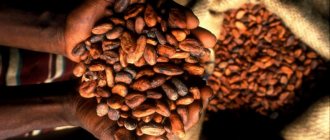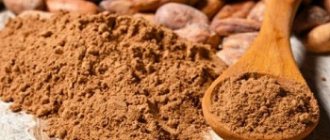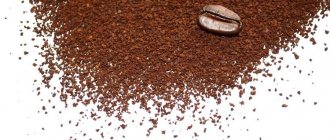Coffee is the most popular natural drink, which has a rich composition. It consists of numerous structural elements of organic and inorganic nature, affecting the human body in different ways. Freshly roasted coffee beans contain about a thousand different chemical compounds. So what does coffee contain and what effect does it have?
General information about the chemical composition
Coffee beans contain many biologically active components, but their concentration varies significantly depending on the method of preparing the raw material. These compounds are acidic or alkaline in nature depending on their structure.
Raw grains contain up to 12% liquid, about 8% sugary substances and the same amount of tannins. The share of fiber in fresh raw materials accounts for about a quarter of the dry residue. The alkaloid content in grains reaches 12%. Coffee beans necessarily contain fats, as well as proteins and carbohydrates in small quantities.
After roasting, coffee raw materials lose a significant amount of water, carbohydrates, and tannins. At the same time, the concentration of fats and alkaloids increases. Heat treatment promotes the storage of acids, vitamins and essential microelements.
Content of proteins, fats and carbohydrates
Coffee beans, in addition to a huge number of active substances and aromatic compounds, contain three main groups of components:
- squirrels
- fats
- carbohydrates
Their ratio depends on the type of coffee, the method of preparation and the growing conditions of the plant.
Squirrels
The content of protein compounds strongly depends on the species of a particular coffee crop. The dependence of the concentration of alkaloids on the number of proteins was revealed. During storage, their quantity does not change in any way, but a tendency towards an increase in the water-soluble fraction is noticed.
In addition to proteins, the group of nitrogenous compounds includes more than 20 free-type amino acids. Their quantity does not change in any way during storage. High-grade coffee contains a predominant amount of them in its composition.
Fats
In coffee beans, the concentration of oily compounds depends on the species. The minimum amount of fat is found in coffee grown in India. Coffee oil has the peculiarity of a large number of esters. Saturated fatty acids in the oil make up more than half. The content of linoleic acid predominates.
The qualitative composition of the oily component is identical for all coffee crops. With increasing storage time, a tendency to slow down oxidative processes has been observed.
Carbohydrates
Complex and simple sugars in coffee beans have a strong influence on the taste of the finished drink. They can serve as precursors for the formation of volatile structures obtained during roasting. These compounds give the drink a special aroma.
Carbohydrates in coffee are found in the form of glucose, fructose, galactose and sucrose, the concentration of which is about 30% of the water-soluble fraction. Each type of coffee contains a certain amount of sugars. During storage, their concentration does not change much.
The composition of coffee beans includes fiber, which occupies almost a third of the volume; it gives density to the grain. This property does not allow the raw material to be severely destroyed or boiled, increasing in volume. Fiber helps preserve the aromatic compounds that give the drink its special smell. This compound is quite stable; different types of coffee plants do not differ in its content.
Where is it contained?
Besides cocoa, theobromine is found in coffee beans, kola nuts, guarana berries, yerba mate and the tea plant.
Cocoa powder contains from 2 to 10% theobromine, with an average of 2057 mg per 100 g. In kola nuts it is slightly less - 1.0–2.5%.
The main alkaloid in tea leaves is caffeine, the amount of which reaches 3–5% of the dry matter. The content of theophylline and theobromine in tea does not exceed 0.6–0.8%. Processing slightly reduces the amount of alkaloids - up to 20% is lost.
Some medicinal herbs contain theobromine in amounts comparable to green tea. Thus, in fireweed angustifolia (fireweed) during the flowering period it is 20–50 mg per 100 grams.
The theobromine content in coffee has no practical significance. The alkaloid is located in the middle of the grain, so it is lost during roasting and grinding. Even in raw coffee beans, the theobromine content is insignificant - 1.5–2.5 mg per 100 g.
In finished food products, the percentage of alkaloid depends mainly on the amount of cocoa in them.
Table No. 1 - theobromine content in chocolate.
| Type of chocolate | Amount of theobromine in 1 g |
| Bitter | up to 16 mg |
| Dark | 5.5 mg |
| Lactic | 2.4 mg |
| White | less than 0.1 mg |
Thus, how much theobromine is in a chocolate bar depends on its type. In the dark, this figure is approximately 550 mg.
Table No. 2 - theobromine content in other foods.
| Product | Amount of theobromine in 100 g |
| Cocoa powder | 2000–2600 mg |
| Chocolate baked goods | 1500 mg |
| Chocolate drinks | 800 mg |
| Chocolate candies | 500–700 mg |
| Chocolate bar | 50–100 mg |
| Chocolate ice cream | 60 mg |
| Chocolate cupcake | 215 mg |
| Tea blend | 20–40 mg |
| Decaffeinated tea blend | 4–10 mg |
| Green tea | 1.0 mg |
The theobromine content in cocoa beans varies quite widely - from 0.88 to 2.34% (the amount of caffeine is 0.05 to 0.36%).
It is noteworthy that the most expensive varieties of cocoa do not always have a high content of theobromine. It is believed that the taste of cocoa depends not so much on the presence of this alkaloid, but on the ratio of all the components of the beans.
Alkaloids
Coffee contains abundant amounts of alkaloids, but only some of them are capable of producing physiological effects. As the coffee bean matures, it accumulates two main alkaloids:
- caffeine
- theobromine
The first is stored in the shell of the product, the second in the inner part. If the drink is made from unprocessed whole grains, then both nitrogenous substances are present. Coffee alkaloids determine the tonic effect of the drink on the body.
Caffeine
This alkaloid is an important component of coffee. It is this that causes all the physiological effects caused by the tonic drink. In its pure form, this substance has no distinct odor or color, but it can be identified by its rather bitter taste. This substance has high solubility in polar liquids and a neutral reaction in the environment. In coffee, the alkaloid is found in monovariant or associated with sour potassium in salt-type compounds.
The concentration of the main nitrogenous compound determines the quality of coffee. Each type of this drink differs in its concentration of alkaloid. This is influenced by the natural conditions in which the raw materials were grown.
Caffeine is responsible for the main effect of the drink. This is primarily a stimulation of the nervous system. But with frequent use it can cause slowness in the conduction of nerve impulses. And in abundance it can provoke exhaustion of the body.
Theobromine
This nitrogenous compound, like caffeine, has a pronounced bitter taste. It differs from caffeine in its saturation with methyl groups. Theobromine is poorly soluble in aqueous media and occurs in the form of crystalline hydrate. This alkaloid is most often clear or white in color.
This substance acts almost like caffeine, but the effect is not as pronounced. Theobromine has a high affinity for the cardiovascular system. It has a positive effect on the functioning of the heart muscle, increasing its contractility and improving the functioning of the coronary arteries. The most pronounced effect is noticeable on the muscles involved in breathing. Theobromine also helps reduce blood pressure and reduce renal blood flow. For this reason, after taking a tonic drink, it is necessary to replenish your water balance.
Application
Theobromine is commercially produced in two forms - powder and capsules. The powder has a fine structure and has a bitter taste; it is taken separately as a food additive or mixed with food and drinks.
Theobromine is used in medicine due to its diuretic and bronchodilator effects. It is prescribed for the treatment of bronchopulmonary diseases, including asthmatic ones. Theobromine salt and sodium salicylic acid - “Diuretin” (Diuretinum) are used as a diuretic.
Theobromine increases the strength of tooth enamel. However, this property appears only in pure solutions, and not in the composition of cocoa. There is a special toothpaste with theobromine - Theodent, which promotes enamel remineralization.
Thus, theobromine can be consumed as a separate dietary supplement or in the form of cocoa and cocoa products. Or use it in toothpaste.
Taurine
Taurine is a substance with a structure similar to an amino acid. Antioxidants in coffee are represented by this substance. This compound is usually synthesized in the human body. Taurine in coffee can have a beneficial effect on the body.
Positive effects of this substance:
- pronounced antioxidant effect, which prevents carcinogenesis;
- decreased blood sugar levels;
- regenerative effect on the optical structures of the eye;
- hypotensive effect;
- participation in the metabolism of calcium, sodium and potassium;
- positive effect on the nervous system.
Chlorogenic acids
Phenolic compounds in coffee beans are represented by chlorogenic acids. Esters of cinnamic acids reach the highest concentrations. Esters of caffeic and ferulic acids are also found. These compounds are responsible for the acidity of coffee.
The content of these compounds in grain reaches 10%. Their content decreases during roasting as they are destroyed by temperature. Chlorogenic acids give beans their dark color after roasting. The greater their concentration, the darker the color.
Vitamins and microelements
Coffee made from beans of natural origin contains a large amount of vitamins and microelements. Vitamins in coffee are widely represented. They play an important role in human physiology. What vitamins are present in the drink:
- Niacin is a substance that regulates oxidation processes in cells. Helps normalize blood cholesterol levels and participates in the processes of synthesis of energy reserves. has a significant effect on the metabolism of amino acids in the body.
- Thiamine is a vitamin that affects the metabolism of carbohydrates and proteins. It affects the functioning of almost all organs.
- Vitamin B2 is a substance that helps accelerate metabolic processes. Promotes the binding of oxygen by cells.
- The remaining vitamins are presented in smaller quantities and are not able to influence the physiology of the body.
In addition to vitamins, the drink contains a sufficient amount of microelements. These are the following substances:
- calcium—affects connective tissue cells, ensuring their health and the normal course of physiological processes;
- magnesium - normalizes the functioning of cardiomycytes, restores heart rhythm. Also necessary in the formation of the bone skeleton and normalization of blood sugar levels;
- sodium - ensures the proper functioning of intercellular structures, normalizes the speed of impulses. This element has a beneficial effect on heart function and muscle contraction;
- Phosphorus is a necessary element that restores proper metabolism. Promotes regeneration of damage in the body;
- iron is an important trace element that is directly related to the amount of hemoglobin in the blood. It affects the normal course of all processes in the body.
Natural coffee, grown in environmentally friendly conditions, is not capable of having a harmful effect on the body. It does not contain harmful substances and oxidation products. But you must always adhere to the norm when drinking this drink.
Experiments with coffee
When coffee first appeared in Europe, many had concerns about the safety of this exotic drink.
The Swedish king Gustav III was especially fearful of it - he was sure that sooner or later this drink would kill a person. He instructed to test his hypothesis with the help of an experiment. Two prisoner twins sentenced to death had to drink different drinks: one - tea, the other - coffee, and three pots of coffee per day. Death was expected to occur within a couple of years, so the death sentence was overturned. As a result, the twins lived happily ever after. The one who drank tea died first, at the age of 83. Some scientists believe that this was the first ever clinical study on coffee. Others say that this is fiction and a hoax. Be that as it may, the king himself never learned anything about the results: he died at the age of 46 from a shot in the back. Modern research on coffee, aimed at tracking the harm or benefit it causes to human health, proceeds approximately according to the principle established by the Swedish king. These are usually long-term observations of participants, some of whom are coffee drinkers and drink several cups a day every day, and others who drink minimal or no coffee at all.











